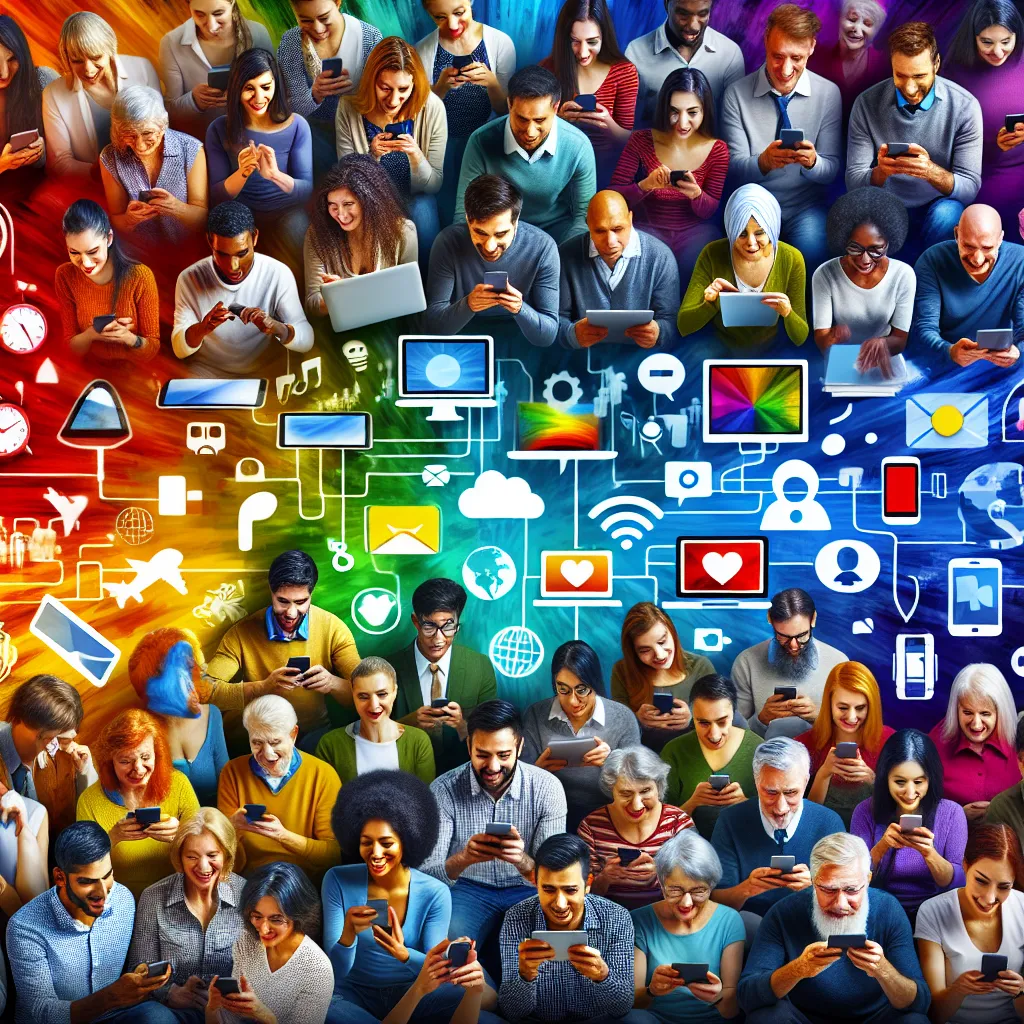In recent IELTS Speaking tests, topics related to modern communication methods have become increasingly prevalent. Examiners often ask candidates to discuss new ways of communicating they’ve recently adopted, as this subject allows them to assess a wide range of language skills. Let’s explore how to effectively answer questions on this topic and maximize your IELTS Speaking score.
Table Of Contents
 Modern Communication Methods
Modern Communication Methods
Part 1: Introduction and Interview
In this section, the examiner may ask you some general questions about communication. Here are a few examples:
- How do you usually communicate with your friends and family?
- Has technology changed the way you communicate with others?
- Do you prefer face-to-face communication or online communication?
Let’s look at a sample answer for the second question:
Examiner: Has technology changed the way you communicate with others?
Sample Answer (Band 7-8):
“Absolutely! Technology has revolutionized the way I communicate with others. In the past, I primarily relied on phone calls and text messages, but now I use a wide array of digital platforms. For instance, I frequently use video calling apps like Zoom for work meetings and catching up with friends abroad. Social media platforms such as Instagram and Facebook have also become integral to how I stay connected with my wider social circle. These technological advancements have made communication more instantaneous and versatile, allowing me to stay in touch with people regardless of distance or time zones.”
Key features:
- Use of advanced vocabulary: “revolutionized,” “wide array,” “integral”
- Specific examples provided
- Clear structure and coherent ideas
- Expression of personal opinion
Part 2: Long Turn
Here’s a sample cue card related to the topic:
Describe a new way of communication you adopted recently
You should say:
- What this new method of communication is
- When you started using it
- How you learned to use it
- And explain why you decided to adopt this new method
Sample Answer (Band 8-9):
“I’d like to talk about a new communication method I’ve recently adopted, which is using the social audio app Clubhouse. I started exploring this platform about six months ago when it gained significant popularity during the pandemic.
Clubhouse is an innovative audio-based social networking app where users can join virtual rooms to discuss various topics. What sets it apart is that it’s entirely voice-based, with no video or text chat features. This unique approach creates a more intimate and engaging form of communication.
I initially learned about Clubhouse through social media and tech news websites. The app was invitation-only at first, which piqued my curiosity. Once I received an invite from a colleague, I dove right in. The learning curve was relatively gentle – I simply had to create a profile, follow some interesting people and topics, and start joining rooms that caught my attention.
The reason I decided to adopt this new method of communication was multifaceted. Firstly, I was intrigued by the concept of audio-only social networking, as it offered a refreshing change from the visual-heavy platforms I was accustomed to. Secondly, Clubhouse provided an excellent opportunity to network with professionals in my field and listen to thought-provoking discussions on various subjects. Lastly, as someone who enjoys learning new things, I found the platform to be an invaluable source of knowledge and diverse perspectives.
Using Clubhouse has significantly enriched my communication experience. It’s allowed me to connect with people from all over the world, broaden my horizons, and engage in meaningful conversations on topics I’m passionate about. The spontaneity and authenticity of live audio discussions have made this new communication method a valuable addition to my digital toolkit.”
Key features:
- Detailed description of the communication method
- Clear structure following the cue card prompts
- Advanced vocabulary and idiomatic expressions
- Personal reflections and reasons for adoption
Examiner’s follow-up questions:
- Do you think this new communication method will become more popular in the future?
- How does this method compare to traditional forms of communication?
Sample Answer (Band 8-9):
-
“I believe Clubhouse and similar audio-based social platforms have the potential to gain even more traction in the future. The unique selling point of these apps is their ability to foster genuine connections and facilitate knowledge sharing in a way that feels more personal than text-based platforms. However, their long-term popularity will likely depend on how well they can adapt to user needs and compete with established social media giants. As people become increasingly fatigued with visual content, audio-based communication might offer a refreshing alternative.”
-
“Compared to traditional forms of communication, Clubhouse offers both advantages and drawbacks. On the positive side, it bridges the gap between the immediacy of a phone call and the broad reach of social media. It allows for real-time interactions with a global audience, which wasn’t possible with older communication methods. However, it lacks the non-verbal cues present in face-to-face conversations and the permanence of written communication. Traditional methods like in-person meetings or phone calls might still be preferable for more personal or sensitive discussions. Ultimately, I believe audio-based social platforms will complement rather than replace traditional communication forms, offering users a diverse array of options to suit different needs and preferences.”
Part 3: Two-way Discussion
In this section, the examiner will ask more abstract questions related to the topic. Here are some example questions and answers:
Examiner: How do you think communication technologies will evolve in the next decade?
Sample Answer (Band 8-9):
“I believe we’re on the cusp of a significant transformation in communication technologies. Over the next decade, I anticipate several key developments. Firstly, augmented reality (AR) and virtual reality (VR) are likely to play a more prominent role in how we interact. These technologies could create more immersive experiences, allowing us to feel as if we’re in the same room with someone on the other side of the world.
Secondly, I expect artificial intelligence (AI) to become more integrated into our communication tools. This could lead to more sophisticated translation services, enabling real-time communication across language barriers. AI might also help in filtering and prioritizing our communications, making it easier to manage the influx of information we receive daily.
Lastly, I think we’ll see advancements in haptic technology, which could add a tactile dimension to digital communication. This might allow us to virtually ‘touch’ or ‘feel’ things during video calls, adding a new layer of connection to remote interactions.
However, with these advancements, we’ll likely face new challenges related to privacy, digital addiction, and the potential loss of face-to-face communication skills. It will be crucial to find a balance between leveraging these new technologies and maintaining meaningful human connections.”
Key features:
- Discussion of multiple aspects of future communication technologies
- Use of technical terms and advanced vocabulary
- Consideration of both positive developments and potential challenges
- Well-structured response with clear progression of ideas
Essential Vocabulary and Phrases for High Scores
To achieve a high score in IELTS Speaking, it’s crucial to use a range of advanced vocabulary and idiomatic expressions. Here are some key terms and phrases related to communication:
-
Revolutionize (verb) /ˌrevəˈluːʃənaɪz/ – to change something completely and fundamentally
Example: “Social media has revolutionized the way we stay in touch with friends and family.” -
Instantaneous (adjective) /ˌɪnstənˈteɪniəs/ – happening or done immediately
Example: “Modern technology allows for instantaneous communication across vast distances.” -
Pique one’s curiosity (phrase) – to arouse someone’s interest or curiosity
Example: “The new communication app piqued my curiosity with its unique features.” -
Multifaceted (adjective) /ˌmʌltiˈfæsɪtɪd/ – having many different aspects or features
Example: “The reasons for adopting new communication methods are often multifaceted.” -
Broaden one’s horizons (phrase) – to expand the range of one’s knowledge, interests, or experiences
Example: “Using international communication platforms can help broaden your horizons.” -
Bridge the gap (phrase) – to connect two different things or reduce the difference between them
Example: “Video calling technology has helped bridge the gap between distant family members.”
Tips from an IELTS Examiner
As an experienced IELTS examiner, I recommend the following strategies to excel in the Speaking test:
-
Practice regularly: Dedicate time each day to speaking English, even if it’s just talking to yourself about various topics.
-
Expand your vocabulary: Learn new words and phrases related to communication and technology, and practice using them in context.
-
Develop your ideas: Don’t just give short answers. Elaborate on your points and provide examples to support your ideas.
-
Work on your fluency: Try to speak smoothly without long pauses. It’s okay to use fillers like “well” or “you know” occasionally, but don’t overuse them.
-
Listen to native speakers: Watch English-language movies, TV shows, and podcasts to familiarize yourself with natural speech patterns and colloquialisms.
-
Record yourself: Practice answering IELTS-style questions and record your responses. Listen back to identify areas for improvement.
-
Seek feedback: If possible, practice with a native English speaker or an experienced teacher who can provide constructive criticism.
By following these tips and consistently practicing, you’ll be well-prepared to tackle any question about new communication methods in your IELTS Speaking test. Remember, the key is to demonstrate your language skills while expressing your thoughts clearly and confidently.
To further enhance your IELTS preparation, you might want to check out our articles on how to describe a situation when you had to quickly adapt to new technology and how to describe a time when you had to solve a problem creatively. These resources will provide additional insights and strategies to boost your performance in the IELTS Speaking test.


